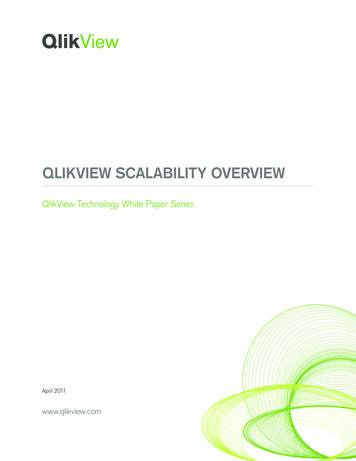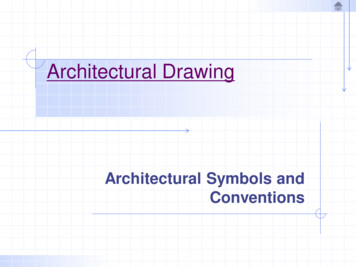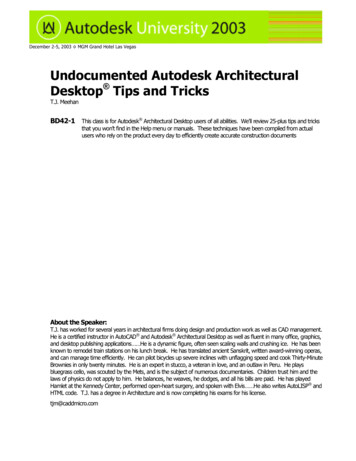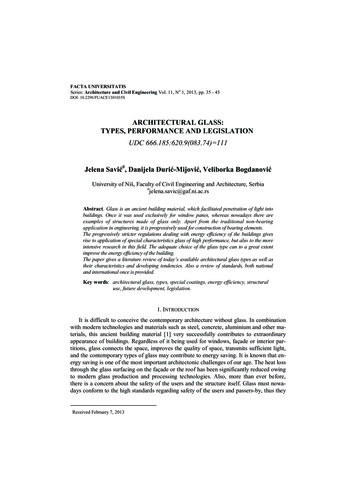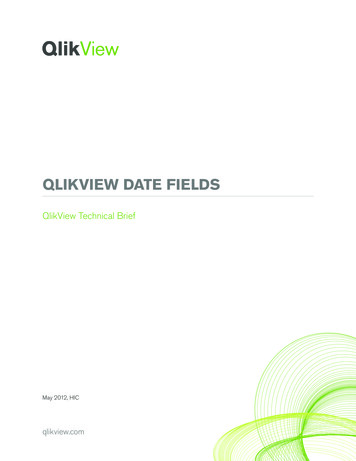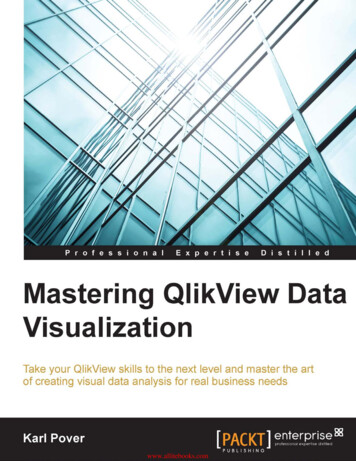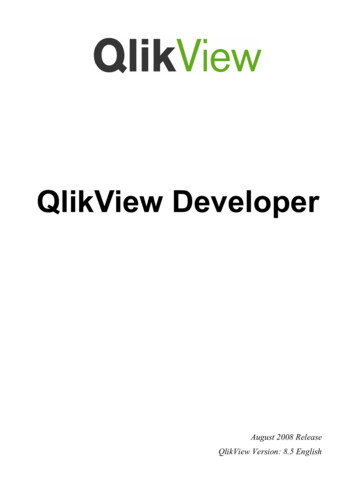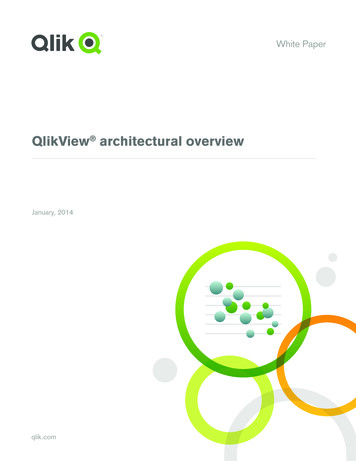
Transcription
White PaperQlikView architectural overviewJanuary, 2014qlik.com
Table of ContentsMaking sense of the QlikView platform3Most BI software is built on old technology3The QlikView difference: the associative experience4Components of the QlikView business discovery platform6QlikView and the IT pro8QlikView and the business analyst / BI developer8QlikView and the business user8How QlikView works: a quick look under the covers9QlikView’s architecture raises the bar for business discovery10Appendix11Related QlikView technology whitepapers and technical briefs11Related QlikView blog articles112 QlikView Architectural Overview
Making sense of the QlikView platformOur customers often ask about what goes on under the hood of QlikView. In this QlikTechnology White Paper we shed light on the inner workings of QlikView from the perspectiveof three roles: IT professional, BI (Business Intelligence) professional (business analyst / BIdeveloper), and business user. The target audience for this paper consists of IT professionalsand tech-savvy business people who are exploring BI solutions. This paper answers thequestion, “What are the basics I should know about the QlikView Business Discovery platformso I can make an informed buying decision?”Most BI software is built on old technologyQuery-based BI tools have been the status quo for decision support for decades now. Manyvariations of query-based BI software are on the market. Some are flexible and others arehigh-performance. But they all share one critical flaw: they are unable to inherently maintainassociations among data elements (see Figure 1). Q uery-based tools divorce data from its context. People making complex businessdecisions don’t always have full access to their supporting data – even when they haveaccess to BI software. Some data is available only as isolated and discrete queries,without context between one query and the next. This leaves gaps for people trying tomake data-driven business decisions. Where there is a query, there is dissociation. With query-based tools, creatingassociations among all available data elements would require a business analyst or ITprofessional to cram every associated field into a single query — a nearly impossibletask. The alternative — hard coding associations among queries into the applicationlayer — is equally daunting.Figure 1 Traditional BI solutions don’t maintain all the data associations 2014 QlikQlikView Architectural Overview 3
The QlikView difference: the associative experienceOne of the QlikView’s primary differentiators is the associative user experience it delivers.QlikView is the leading Business Discovery platform. It enables users to explore data, makediscoveries, and uncover insights that enable them to solve business problems in new ways.Business users conduct searches and interact with dynamic dashboards and analytics from anydevice. Users can gain unexpected business insights because QlikView: Works the way the mind works. With QlikView, users can navigate and interact withdata any way they want to — they are not limited to just following predefined drill pathsor using preconfigured dashboards. Users ask and answer questions on their own and ingroups and teams, forging new paths to insight and decision. With QlikView, discovery isflexible. Business users can see hidden trends and make discoveries like with no other BIplatform on the market. Delivers direct — and indirect — search. With Google-like search, users type relevantwords or phrases, in any order, and get instant, associative results. With a global searchbar, users can search across the entire data set in an application. With search boxesaffiliated with individual list boxes, users can confine the search to just that list box. Theycan both conduct direct and indirect searches. For example, if a user wanted to identify asales rep but can’t remember the sales rep’s name — just details about the rep, such asthat he sells fish to customers in the Nordic region — the user can search on the sales replist box for “Nordic” and “fish” to get the names of sales reps who meet those criteria. Delivers answers as fast as users can think up questions. A user can ask aquestion in QlikView in many different ways, such as lassoing data in charts and graphsand maps, clicking on items in list boxes, manipulating sliders, and selecting dates incalendars. Instantly, all the data in the entire application filters itself instantly around theuser’s selections. The user can quickly and easily see relationships and find meaning inthe data, for a quick path to insight. The user can continue to click on field values in theapplication, further filtering the data based on questions that come to mind. Illuminates the power of gray. With QlikView, users can literally see relationshipsin the data. They can see not just which data is associated with the user’s selections— they can just as easily see which data is not associated (see Figure 1). How? Theuser’s selections are highlighted in green. Field values related to the user’s selectionare highlighted in white. Unrelated data is highlighted in gray. For example, when a userclicks on a product category (say, bagels) and a region (e.g., Japan), QlikView instantlyshows everything in the entire data set that is associated with these selections — as wellas the data that is not associated. The result? New insights and unexpected discoveries.For example, the user might see that no bagels were sold in Japan in January or June,and begin an investigation into why.4 QlikView Architectural Overview
Figure 2 QlikView delivers an associative experience 2014 QlikComponents of the QlikView Business Discovery platformThe QlikView Business Discovery platform consists of 3 major components – QlikView Server,QlikView Publisher and QlikView Desktop, each playing an important part in designing, developingand implementing almost every QlikView deployment (see Figure 3). Each component is usedprimarily by either an IT professional, a business analyst/developer, or a business user.Figure 4 depicts a simplified view of a typical QlikView deployment containing the location ofthe various QlikView products as well as both data and application locations.Figure 3 Components of the QlikView Business Discovery platformIT proBusiness analysts /developerBusiness userWeb and mobileclientsQlikViewMgmt. Console(part of QVS)QlikViewDesktopAccessPoint(part of QVS) QlikView portalQlikView Server (QVS)QlikView Publisher In-memory engine Client/server communication Data reload Document distributionData Sources 2014 QlikQlikView Architectural Overview 5
Figure 4: Typical QlikView deploymentArchitecture OverviewUser DocumentsQVP or HTTPSClientsQlikViewServerQlikView qvwFront endQVPBack endSourceDocumentsQlikView qvw andqvd file SAN StorageQlikViewPublisherDirectoryCatalogue(Active Directory,E-Directory)DATAWAREHOUSEData Source 2014 Qlik6 QlikView Architectural Overview
QlikView DesktopThe QlikView Desktop is a Windows-based desktop tool that is used by business analystsand developers to create a data model and to lay out the graphical user interface (GUI orpresentation layer) for QlikView apps. It is within this environment where a developer will usea SQL-like scripting environment (augmented by ‘wizards’) to create the linkages (connectionstrings) to the source data and to transform the data (e.g. rename fields, apply expressions)so that it can be analyzed and used within the UI, as well as re-used by other QlikView files.The QlikView Desktop is also the environment where all user interface design and userexperience is developed in a drag-and-drop paradigm: everything from graphs and tablescontaining slices of data to multi-tab architectures to application of color scheme templatesand company logos is done here.The file type that is created using the QlikView Desktop is known as a QVW (.qvw, or QlikViewfile). Upon reload, a QVW can be used to create a data-only QVD (QlikView data) file, which isbinary and contains no UI.QlikView Server (QVS)The QVS is a server-side product that contains the in-memory analytics engine and whichhandles all client/server communication between a QlikView client (i.e. desktop, IE plugin,AJAX or Mobile) and the server. It includes a management environment (QlikView ManagementConsole) for providing administrator access to control all aspects of the server deployments(including security, clustering, distribution etc.) and also includes a web server to providefront-end access to the documents within. The web server’s user portal is known as AccessPoint. (It’s important to note that while the QVS contains its own web server, one can alsoutilize Microsoft IIS (Internet Information Server) for this purpose, too). The QVS handles clientauthorization against existing directory providers (e.g. Microsoft Active Directory, eDirectory)and also performs read and write to ACLs (access control lists) for QVW documents.QlikView PublisherThe QlikView Publisher is a server-side product that performs two main functions:1) It is used to load data directly from data sources defined via connection strings in the sourceQVW files.2) It is also used as a distribution service to reduce data and applications from source QVWfiles based on various rules (such as user authorization or data access privileges) and todistribute these newly-created documents to the appropriate QlikView Servers or as staticPDF reports via email.Data sources that can be readily accessed by QlikView include standard ODBC orOLEDBcompliant databases, standard flat files such as Microsoft Excel, XML, etc. as wellas from systems such as SAP NetWeaver, Salesforce.com, and Informatica.QlikView Architectural Overview 7
QlikView and the IT proQlikView’s approach to BI allows for a self-service model for business users on the front end whilemaintaining strict data security and governance on the back end. Because of this approach, ITprofessionals—from enterprise architects to data analysts — can remain focused on their corecompetencies: data security, data and application provisioning, data governance and systemmaintenance. They no longer have to spend time writing and re-writing reports for business users.In a typical QlikView deployment, IT professionals focus on: Managing data extracts and data and system security Creating and maintaining source QlikView files (QVWs and QVDs) Controlling data refresh and application distribution through QlikView Publisher Administering QlikView deployments via the QlikView Management Console(part of QVS)QlikView and the business analyst / BI developerThe role of a business analyst or BI developer in a typical QlikView deployment primarily involvesthe use of QlikView Desktop. QlikView developers use this Windows desktop application toextract data from source systems, create data models, and transform the data. It is where theydescribe all metadata, create data storage layers (QVD layers), and lay out the user interface.The BA or BI developer can also reuse existing extracted and pre-modeled data from the QVDlayer by pulling “off-the-shelf” data from the QVD, when relevant for their application.The BA or BI developer also wants to ensure that their QlikView business applications are usingthe most recent data and that QlikView apps are being distributed to the correct business usercommunity. For this reason, BAs and BI developers typically work closely with IT pros who useQlikView Publisher on the back end to ensure data refresh rates and QlikView Server on thefront end to ensure the applications are correctly distributed and meet the business’ needs.QlikView and the business userBusiness users interact with QlikView applications exclusively via the front end of a deployment,most typically using a browser on their desktop, laptop, or mobile device (such as an iPad).Users simply open their AccessPoint portal (or, in the case of integrated solutions, theirorganization’s own enterprise portal) and select the QlikView application they wish to use.QlikView Server provides all client-server communication and is the engine that drives thein-memory associative experience. Once the user’s security credentials are verified, they thenopen and can begin working with the application, exploring and interacting with the data andasking and answering their own stream of questions in a self-service mode. Users can alsocollaborate with other users in the organization, sharing insights and exploring data together, inreal time or asynchronously.8 QlikView Architectural Overview
How QlikView works: a quick look under the coversWhen a QlikView document is published on a QlikView Server, the content it contains becomesavailable for consumption by any user with privileges to access it. QlikView works like this: When a user first opens a QlikView document, data is loaded in memory. Thecompressed and unaggregated dataset is loaded off the disk and into the QlikViewServer’s RAM (random access memory). This in-memory repository serves as thebase dataset for this initial user and all other users requesting the same document.This repository stays in memory until no user activity has occurred within a definedtime-out period. Users explore data via selections. Central to QlikView is the concept of a userdefined selection state. As users click around in a QlikView document, they indicatewhich subsets of data they are interested in analyzing and which subsets should beignored. QlikView takes advantage of the highly indexed nature of the unaggregateddataset. QlikView dynamically presents a subset of all the data available to the QlikViewdocument based on the selection state. This happens in real time as the user executesclicks. Upon selection, aggregates render instantly. On the fly, QlikView rendersaggregates as intuitive and interactive user interface objects: charts, graphs, tables, etc.Users interact with objects
handles all client/server communication between a QlikView client (i.e. desktop, IE plugin, AJAX or Mobile) and the server. It includes a management environment (QlikView Management Console) for providing administrator access to control all aspects of the server deployments (including security, clustering, distribution etc.) and also includes a web server to provide front-end access to the .
